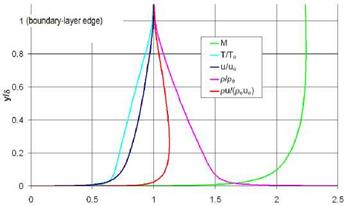Displacement Thickness at a Highly Cooled Wall
In three-dimensional boundary-layer flow the displacement thickness Ji can become negative [3]. This typically happens if the flow diverges strongly, for instance at attachment lines. Regarding two-dimensional flow one expects intuitively that J1 will always be positive. However, if the wall is highly cooled, J1 may become negative. This effect is illustrated with the example of a rocket-nozzle boundary-layer flow [5]. The flow was computed with an high-temperature real-gas model, turbulent flow was assumed. We consider the situation at a location downstream of the nozzle throat. Table 10.3 gives the boundary-layer edge flow parameters (e) and the wall temperature Tw.
|
Table 10.3. Parameters of the nozzle-flow case with a highly cooled wall [5].
|
The results in terms of the parameters stream-wise Mach number M, static temperature T, wall-tangential velocity u, density p, and the wall – tangential mass flux pu are given in Fig. 10.2. Except for the Mach number they each were made dimensionless with their boundary-layer edge value.
|
Fig. 10.2. Rocket-nozzle flow downstream of the nozzle throat [5]. Dimensionless distributions of Mach number M, temperature T/Te, velocity u/ue, density p/pe, and mass-flow pu/(peue) across the boundary layer. The boundary-layer edge values are given in Table 10.3. |
The wall to edge temperature ratio is Tw/Te « 0.2. Accordingly the density ratio is pw /pe « 5 (the respective graph in the figure extends outside to the right). The mass flux pu in the boundary layer at maximum is almost 12 per cent higher than that at the boundary-layer edge. The resulting displacement thickness, eq. (7.108), is negative with Ji = —0.27 m.[173]












